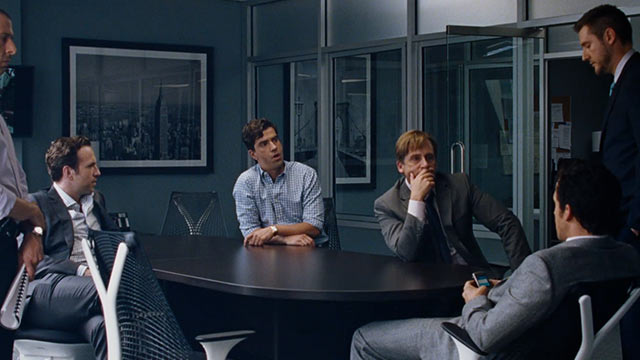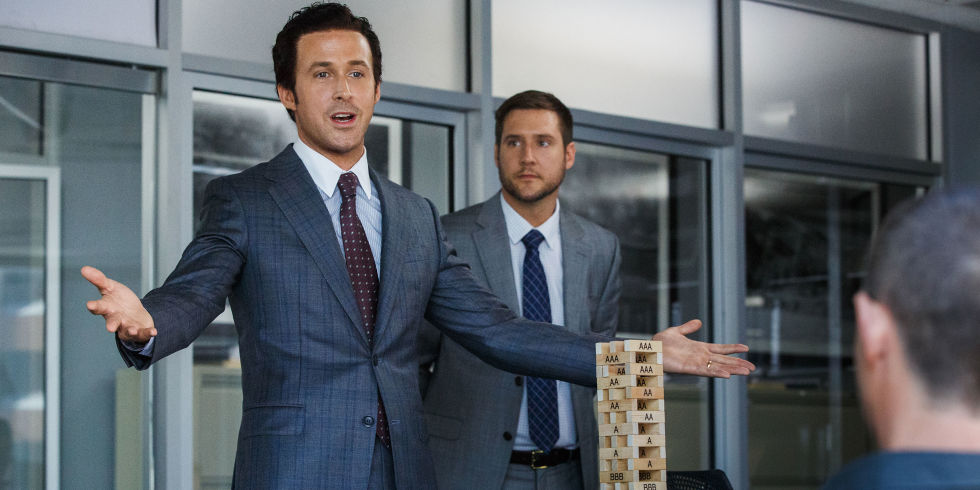Mo’ Problems.
Actors can learn to fight bad guys convincingly. Actors can learn to play instruments convincingly. So it should stand to reason that actors also can learn to discuss credit default swaps convincingly. However, the sheer mastery with which these actors discuss these credit default swaps is a testament to how successfully the vision of The Big Short has been realised. That vision being, it would seem, to make the global financial crisis digestible and understandable even to people who spend their time fighting bad guys and pretending to play instruments. You get the sense that not only did they learn their lines, but they actually learned how this stuff works.
The Big Short is a lot of things, but at its core it’s an explanation tool. It very much wants us to finally understand the economic conditions in the housing market and banking industry in the middle of the last decade, just before the housing bubble burst and the global economy went to shit. And it’ll use literally anything it thinks can help us with that. As just one, though possibly not even the most random example: The task of explaining sub-prime loans falls to Australian actress Margot Robbie, playing herself, sitting in a bubble bath drinking champagne from a flute. Not only does she do a good job of conveying the concept, but when she’s done, she tells you the viewer to piss off.
Starting to get the picture about The Big Short? It’s not a comedy, exactly, but it’s not a drama exactly, either. It’s no doubt a major step forward for Adam McKay, heretofore associated primarily with comic actor Will Ferrell, who just this past week was rewarded for his efforts with an Oscar nomination for best director to join the film’s nomination for best picture. And perhaps it took someone with McKay’s comedic sensibilities to help us understand a major piece of recent world history that is in many ways a total farce.

The story focuses on several tangentially related banking industry figures who had the foresight to see that mortgage-backed securities were about to collapse, when no one else did. One is an eccentric social oddball with a glass eye, Michael Burry (Christian Bale), whose understanding of numbers has made the hedge fund he manages a lot of money. Another is a slick trader, Jared Vennett (Ryan Gosling), who gets wind of Burry’s plan to bet against mortgages and starts to investigate it further. (Vennett also narrates the film.) Yet another is a second hedge fund manager, Mark Baum (Steve Carell), whose bull-in-a-china-shop mentality has made him as many enemies as friends, and who learns of Vennett’s investigations as a result of an incorrectly dialled phone number. A fourth team of young investors (John Magaro and Finn Wittrock) also get in on the act, bringing in a reluctant and happily retired financial whiz (Brad Pitt). Pretty soon they’re all making gambles that fly in the face of all conventional financial wisdom and leave their organisations teetering on the verge of total collapse. Of course, to win financially they must collapse morally, as their position will be insured by the failure of the U.S. economy and the loss of millions of jobs and homes.
If you’re getting a sense of how difficult it can be to root for the success of our many characters who function as co-protagonists, you aren’t fully appreciating the complexity of The Big Short. McKay and co-writer Charles Randolph have rigged it so we want to see these guys win, even though their victory means a much greater loss for a much larger swath of the general public, innocents and guilty alike. The more we learn about the recklessness with which loans were written and the credulity with which agreements were signed, the more we just want someone to be right for a change. And history has already told us who’s going to be right on this particular bet.

The whole movie careens forward with a certain madcap energy that remains addictively entertaining while defying comparison to anything else. Robbie’s bubble bath economy lecture is just one example of this movie’s outside-the-box thinking, which also includes similar asides to the camera by chef Anthony Bourdain and former Disney star Selena Gomez. Actual characters in the story will also break the fourth wall, advising us of small discrepancies between what really happened (as documented faithfully in Michael Lewis’ book) and what, for example, is the most expedient way to convey information in a movie. The film regularly uses montage to progress the story, though what makes that approach so interesting is that the images are not always explicably relevant to what is being discussed. What’s more, the editing will frequently cut songs, shots, even lines of dialogue short of their natural endpoint, giving a further sense of the messiness and chaos of it all. It’s truly a case of throwing spaghetti against the wall, except that in the typical instance of that exercise, most of the spaghetti doesn’t stick. The Big Short is like a Jackson Pollock painting of spaghetti that has incredible, sometimes inexplicable sticking power.
The all-star cast really sells it. The heavy hitters collected to present this information all have one foot in the world of comedy and one foot in the world of drama, all capable of delivering a funny line but also of expressing the tragedy of a system where shrewd analysts were forced to become rich merely by refusing to ignore the dire trends they forecasted. If there’s anywhere The Big Short feels like too much of a concession to traditional Hollywood morals, it’s that each character shows a heavy sorrow over their eventual collection of millions or even billions of dollars, because it’s a byproduct of the death of the American dream for many others. One suspects that they were far less solemn about making a fortune – but The Big Short doesn’t need to tell us the hard truth about everything.
9/10
For more Reviews, click here. If you’re digging ReelGood, sign up to our mailing list for exclusive content, early reviews and chances to win big!
